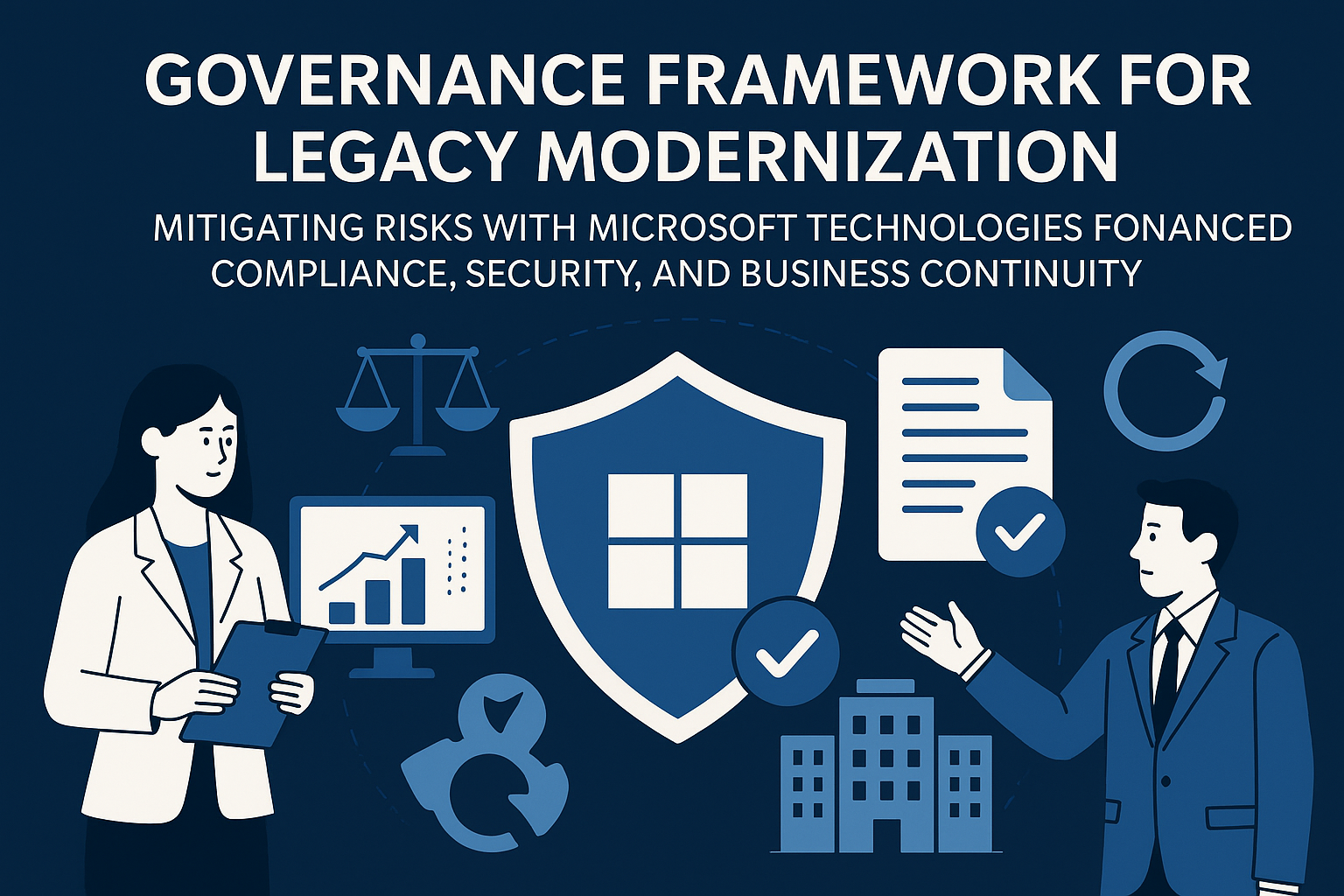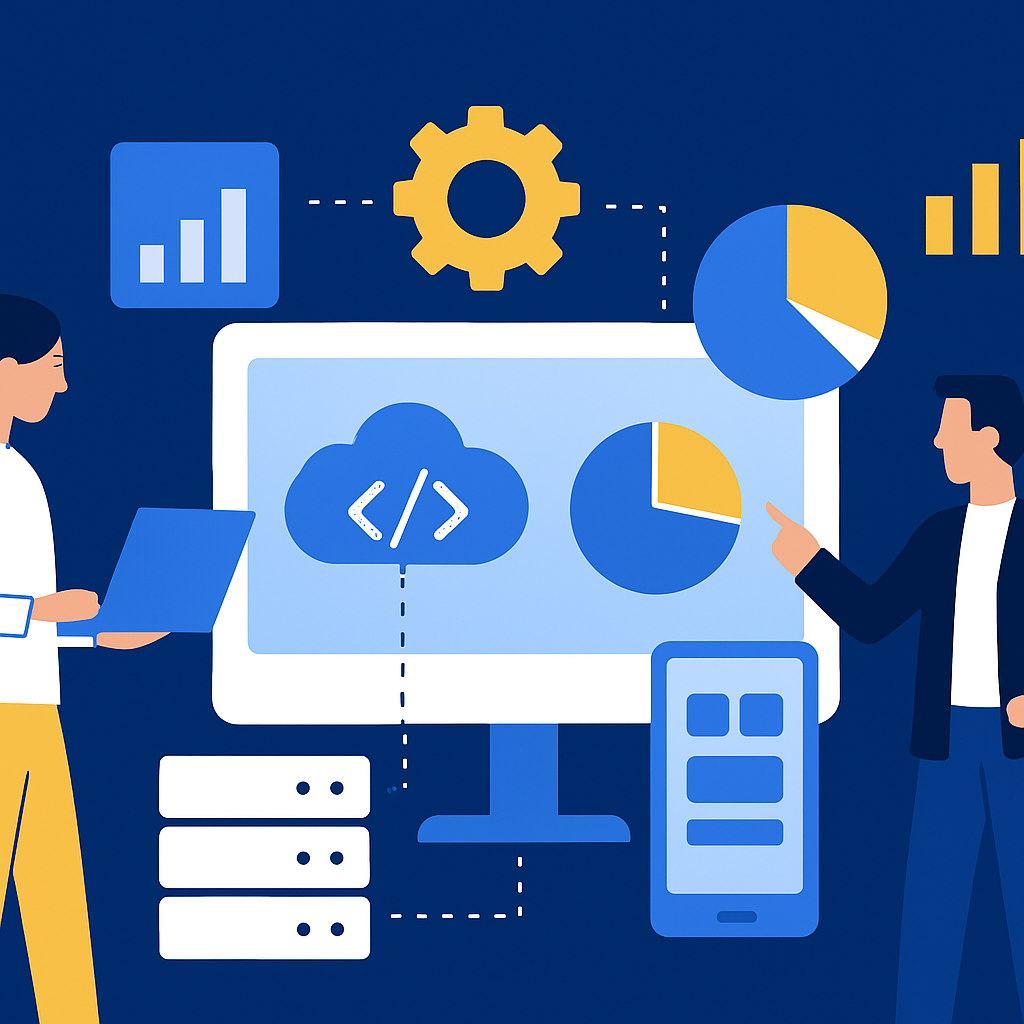
Why Legacy Modernization Projects Fail: The Governance Gap
Legacy modernization initiatives fail at alarming rates—industry studies show 70% of digital transformation projects miss objectives or fail entirely. Technical challenges certainly contribute, but the primary cause is governance failure.
Organizations launch modernization without clear decision-making frameworks, undefined success criteria, inadequate risk management, insufficient stakeholder alignment, and absent change control processes. What starts as a technology upgrade becomes an organizational crisis.
Effective governance does not slow modernization—it enables it by providing structure, clarity, and confidence that allow organizations to move decisively while managing risk appropriately.
What Legacy Modernization Governance Actually Means
Governance is not bureaucracy. It is the framework ensuring modernization initiatives deliver intended value while managing risks acceptably. Effective governance balances innovation with control, progress with prudence, and speed with safety.
Core Governance Components
Decision Rights and Accountability: Who makes what decisions? Who is accountable for outcomes? Clear assignment prevents paralysis and finger-pointing when challenges arise.
Risk Management Framework: How are risks identified, assessed, and mitigated? What risk levels are acceptable? When are escalations required?
Compliance Controls: How is regulatory compliance maintained during and after modernization? What validation is required? How are compliance gaps addressed?
Change Management Process: How are changes evaluated and approved? What testing is required? How are rollbacks handled?
Performance Monitoring: How is progress measured? What metrics indicate success or problems? How frequently is performance reviewed?
The QueryNow Legacy Modernization Governance Framework
Our framework has evolved through dozens of successful modernization projects across heavily regulated industries. It balances necessary controls with the agility modernization requires.
Governance Structure
Executive Steering Committee: Senior leaders from business and IT providing strategic direction, resolving major issues, and allocating resources. Meets monthly to review progress, address escalations, and ensure organizational alignment.
Program Management Office: Day-to-day coordination, risk management, issue resolution, and stakeholder communication. Provides structure without micromanagement.
Technical Architecture Board: Evaluates technical decisions, ensures architectural consistency, and validates technical risk mitigation. Prevents technical debt accumulation during modernization.
Business Working Groups: Subject matter experts from affected business units ensuring modernization meets operational needs and maintaining business continuity.
Risk and Compliance Team: Validates regulatory compliance, assesses risks, and ensures appropriate controls throughout modernization.
Risk Management Approach
Legacy modernization introduces multiple risk categories requiring different mitigation approaches:
Operational Risks: Business disruption from system outages or performance degradation. Mitigation: Phased rollouts, parallel operation during transition, comprehensive rollback plans, and off-hours implementation windows.
Data Risks: Data loss, corruption, or unauthorized access during migration. Mitigation: Multiple backup layers, validation checkpoints, encryption throughout migration process, and audit logging of all data access.
Compliance Risks: Regulatory violations during or after modernization. Mitigation: Compliance validation at each phase, regulatory expert involvement, documentation of control maintenance, and audit trail preservation.
Security Risks: New vulnerabilities introduced by modern systems or exposed during transition. Mitigation: Security architecture review, penetration testing, continuous vulnerability scanning, and security incident response procedures.
Financial Risks: Cost overruns or failure to achieve projected ROI. Mitigation: Phased funding, performance-based vendor contracts, continuous ROI tracking, and go/no-go decision points.
Organizational Risks: User resistance, capability gaps, or inadequate change adoption. Mitigation: Comprehensive change management, user involvement throughout, training programs, and adoption metrics.
Compliance Management
Regulated industries require special attention to compliance throughout modernization:
Compliance Baseline Assessment: Document current compliance posture and control mechanisms in legacy systems. Understand what must be preserved or enhanced.
Regulatory Mapping: Map regulatory requirements to technical controls in both legacy and target architectures. Ensure no compliance gaps during transition.
Validation Checkpoints: Mandatory compliance validation at key milestones before proceeding to next phase. Independent review confirms control effectiveness.
Audit Trail Preservation: Maintain complete audit trails throughout modernization. Demonstrate continuous compliance even during system changes.
Regulatory Communication: Keep regulators informed of major system changes as required. Proactive communication prevents regulatory surprises.
Change Control Process
Structured change control prevents chaos during modernization while enabling necessary agility:
Change Classification: Standard changes follow streamlined approval. Significant changes require architecture review. Critical changes need executive approval.
Impact Assessment: Every change assessed for business impact, technical risk, compliance implications, and resource requirements before approval.
Testing Requirements: Defined testing standards based on change criticality. Automated testing where possible. User acceptance testing for business-facing changes.
Rollback Plans: Every significant change deployed with tested rollback procedure. Rollback decision criteria defined in advance.
Change Documentation: Comprehensive documentation of what changed, why, testing results, and approval trail. Essential for compliance and troubleshooting.
Performance Monitoring and Reporting
Continuous visibility into modernization progress and outcomes:
Executive Dashboard: High-level metrics on schedule, budget, risks, and business value delivery. Monthly steering committee reviews.
Technical Metrics: System performance, availability, security posture, and technical debt levels. Weekly technical team reviews.
Business Metrics: User adoption, process efficiency, cost savings, and revenue impact. Validate business case assumptions.
Risk Metrics: Open risks, risk trends, near-misses, and mitigation effectiveness. Early warning system for emerging problems.
Compliance Metrics: Control effectiveness, audit findings, regulatory communication status, and compliance validation results.
Industry-Specific Governance Considerations
Financial Services
Banks and investment firms face stringent regulatory oversight requiring enhanced governance:
Regulatory Coordination: Formal communication with regulators about major system changes. Pre-approval may be required for critical systems.
Data Sovereignty: Ensure data residency requirements maintained during cloud migration. Geographic restrictions on data movement.
Audit Requirements: Enhanced audit trail requirements for financial transactions. SOC 2 Type II attestations for service providers.
Business Continuity: Stringent RTO and RPO requirements. Demonstrated disaster recovery capabilities before decommissioning legacy systems.
Healthcare
Healthcare organizations must maintain HIPAA compliance and patient safety:
PHI Protection: Enhanced security controls for protected health information during and after modernization. Business associate agreements with all vendors.
Clinical Safety: Clinical system changes require additional validation ensuring patient safety is not compromised. Clinical stakeholder approval required.
Interoperability: Maintain data exchange with external systems. HL7 and FHIR interface validation.
Medical Device Integration: Special considerations for systems integrating with medical devices. FDA regulatory implications for some changes.
Manufacturing
Manufacturing modernization must maintain operational continuity:
Production Impact Minimization: Changes scheduled around production schedules. Minimize manufacturing downtime.
Safety Systems: Enhanced governance for safety-critical systems. Independent safety validation.
Supply Chain Coordination: Ensure supplier and customer system integrations maintained. Communication requirements for system changes affecting partners.
Quality System Compliance: ISO 9001 and industry-specific quality system requirements maintained throughout modernization.
Governance Anti-Patterns to Avoid
Governance Theater: Creating elaborate governance structures that generate documentation but not actual risk management. Effective governance adds value, not just process.
Paralysis by Committee: Requiring excessive approvals that slow progress without improving decisions. Governance should enable decisions, not prevent them.
One-Size-Fits-All: Applying same governance rigor to all changes regardless of risk. Right-size governance based on actual risk levels.
Technology Focus: Governing only technical aspects while ignoring organizational, process, and adoption risks. Comprehensive governance addresses all risk dimensions.
Absent Accountability: Diffuse responsibility where no one is clearly accountable for outcomes. Governance requires clear ownership.
Building Governance Capability
Effective governance is not just processes and committees—it is organizational capability:
Executive Engagement: Senior leadership must actively participate in governance, not delegate entirely to middle management.
Cross-Functional Collaboration: Break down silos between IT, business units, compliance, and risk management.
Risk Intelligence: Develop organizational capability to identify, assess, and manage risks proactively.
Learning Culture: Treat problems as learning opportunities. Blame-free incident reviews that focus on systemic improvement.
Continuous Improvement: Governance framework itself should evolve based on experience and changing circumstances.
The Governance Payoff
Organizations implementing robust modernization governance achieve significantly better outcomes:
Higher Success Rates: Projects with proper governance succeed 2-3x more often than those without.
Lower Risk Realization: Fewer incidents, faster issue resolution, and reduced severity when problems occur.
Improved Stakeholder Confidence: Clear communication and visible risk management build trust enabling bolder transformation.
Regulatory Relationships: Proactive governance improves relationships with regulators who appreciate well-managed change.
Organizational Learning: Governance frameworks capture lessons enabling improved execution of future initiatives.
Getting Started
If your organization is planning legacy modernization—or if previous attempts failed due to risk materialization or inadequate controls—establishing proper governance framework is essential.
Ready for risk-managed modernization? Contact QueryNow for a governance framework assessment. We will evaluate your organizational readiness, design appropriate governance structure, implement risk management processes, and establish performance monitoring enabling confident modernization.


